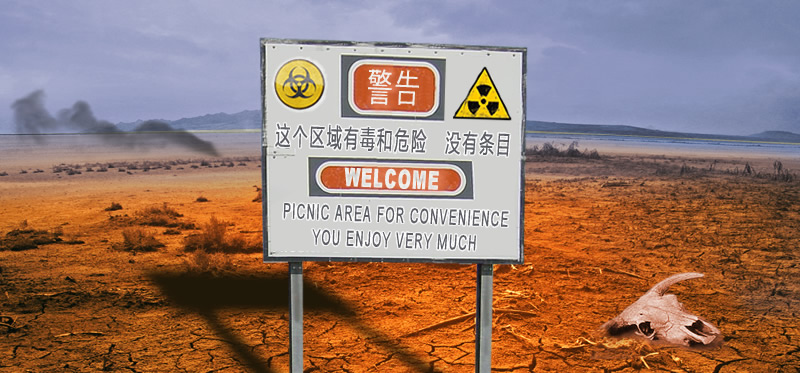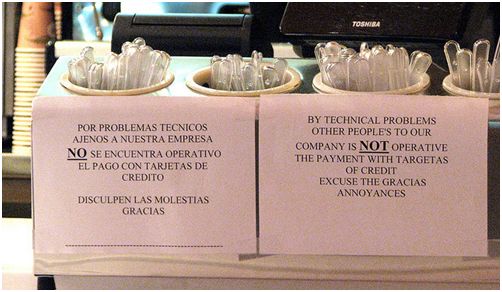The now cliché expression “lost in translation” is often thrown about when referring to misunderstandings between people communicating across language barriers, but in reality it’s incredibly important to be wary of your message being miscommunicated when it comes to the outsourcing of translation services. Look at the following example:
I am increasingly being asked to help companies who were under the impression that they had purchased translation of an extremely high standard from a trusted source, to be later told by others that their translated content is actually a bit rubbish! In some cases not only is the translation poorly written with frequent grammatical and stylistic errors, but there is also a serious case of mistranslation where the meaning has been completely lost or misconstrued. It is in situations like this which leads me to ask; do you trust your existing multilingual content?
 Translation Audit
Translation Audit
If you’re concerned about the quality of your translation then the first thing you need to do is to get a second, third or even fourth opinion. This could simply be contacting colleagues or acquaintances who are native speakers of the language in question. Of course if you really want to know just how bad the content is then I would advise that you contact a professional translation agency to conduct an audit of your existing translation.
Usually an audit or evaluation will be conducted on a sample of the content and should assess the following things: accuracy, style, clarity, and potential grammatical, syntactic and spelling errors. Normally a report will be produced and supplied to you with details as to where these issues have arisen whilst demonstrating what the next step should be.
The outcome of the audit will suggest one of three things:
- The content is actually of a good quality and no further action is required
- The content is of a mediocre quality which can be reviewed and amended to bring it up to standard
- The content is of such a poor quality that it would be cheaper, easier and less time consuming to simply re-translate the content from the original source
Full Content Review
By reviewing the content you are aiming to tidy up your existing translated content making it grammatically and linguistically sound as well as ensuring that your message has not been lost.
Depending on the quality of the existing translation will affect the time and cost involved in the review process. In order to price a project of this sort you should be willing to share all of your pre-existing content with the agency who will schedule the review, as well as the original text used in order to carry out a close comparison of the two sources.
Re-translation
In a worst case scenario, when the quality of your translation is identified as extremely poor, the auditing translation agency may suggest that you have to start from scratch and re-translate the content from the source. Please do not think that this is just a translation agency’s way of getting more money of out you! In this industry we all appreciate a good quality translation and hate to see companies being conned into thinking they’ve got great translated content when really they haven’t.
How to Avoid this…
In most cases when I am asked about translation audits the companies in question had not realised that their translated content was of a poor quality until someone outside of their organisation identified that there was an issue. In some cases customers have even complained about the company’s use of a bad translation. That’s definitely not a good sign!
In these instances the companies tended not to have in-house speakers of their target language who could make an informed judgement of the overall quality of the original translations. They therefore appeared to trust their translation source so much so that they did not feel it necessary to double check the work before using it on their multilingual websites. Uh oh!
Should you have in-house native speakers, or at least know someone who is a native speaker of your target language, it’s really important to get them involved from the get-go. Translation agencies will often ask if you have access to native speakers as they like to get them involved with the whole process, especially when it comes to the final review of the content.
Another piece of advice is to check with your chosen source whether they use human or machine translation. When companies are completely new to translation they often forget to distinguish between the two. As you are probably aware, machine translation is not a safe route to go down and you will never get a translation which is of the same standard as a real, physical human being sitting down and doing the translation themselves. Substandard machine translations can usually be identified quite easily, and in most cases it’s in fact safer to simply retranslate the whole text rather than attempt to review it. Let’s be honest, anyone can run a piece of text through Google Translates and the last thing I want to hear is that someone has been conned into thinking they’re getting a really great translation when they’ve actually paid for someone to do a seriously bad job.
I know it might sound obvious but you also want to get testimonials or references from your chosen translation source just to get an impression of how they have worked with clients in the past, and see direct feedback regarding successful translation projects.
Also ask about samples to see if you can get examples of a translator’s work before deciding to work with a particular agency or freelancer. If you can get hold of a native speaker of your target language then ask them to review the sample on your behalf if you are not familiar with the language in question. Translators always welcome feedback and will appreciate what your contacts have to say in order to build and grow for future projects.
Summary
I hope this information has proved useful and has given you a bit of an insight into how to avoid buying second-rate translations, and the steps to take to both assess and tidy up your existing (questionable!) translations. If you’re worried that your existing multilingual content isn’t very good then please act now! After all it could be hindering your international expansion more than you realise. An excellent translation will make you appear local to your target audience, whereas a poor translation will only alienate you. Make sure your message does not get “lost in translation”.










